Dual-Mode Reconfigurable Frequency-Selective Surface for Switching Between Narrowband and Wideband Applications
Abstract
1. Introduction
2. Design and Analysis of the R-FSS
2.1. Proposed R-FSS Unit Cell Design
2.2. Parametric Analyses
3. Equivalent Circuit Model (ECM) of the R-FSS
4. Fabrication and Experimental Verification
5. Conclusions
Author Contributions
Funding
Data Availability Statement
Conflicts of Interest
Abbreviations
| R-FSS | Reconfigurable Frequency-Selective Surface |
| FSS | Frequency-Selective Surfaces |
| MEMS | Micro-Electromechanical Systems |
References
- Munk Ben, A. Frequency Selective Surfaces: Theory and Design; John Wiley & Sons: Hoboken, NJ, USA, 2005; ISBN 9786610252923. [Google Scholar]
- Anwar, R.S.; Mao, L.; Ning, H. Frequency Selective Surfaces: A Review. Appl. Sci. 2018, 8, 1689. [Google Scholar] [CrossRef]
- Katoch, K.; Jaglan, N.; Gupta, S.D. A Review on Frequency Selective Surfaces and Its Applications. In Proceedings of the 2019 International Conference on Signal Processing and Communication (ICSC), Noida, India, 7–9 March 2019; pp. 75–81. [Google Scholar]
- Montejo-Garai, J.R.; Page, J.E.; Perez-Palomino, G.; Guirado, R. Band-Stop Frequency-Selective Surface (FSS) with Elliptic Response Designed by the Extracted Pole Technique. Sensors 2024, 24, 4452. [Google Scholar] [CrossRef] [PubMed]
- Danuor, P.; Moon, J.-I.; Lee, J.-N.; Jung, Y.-B. A Pattern-Reconfigurable Antenna Using Tunable Band-Stop FSS with Reduced Switching Elements. IEEE Antennas Wirel. Propag. Lett. 2025, 24, 172–176. [Google Scholar] [CrossRef]
- Venkatesh, G.; Thottappan, M.; Singh, S.P. Highly Angularly Stable Dual-Band Stop FSS for Blocking Satellite Downlink Frequencies. IEEE Trans. Electromagn. Compat. 2022, 64, 2055–2059. [Google Scholar] [CrossRef]
- Ren, Y.; Xi, Z.; Liu, Q.; Gong, J.; Sun, Z.; Sima, B. A Wide Passband Frequency-Selective Surface with a Sharp Roll-off Band Using the Filtering Antenna-Filtering Antenna Method. Materials 2024, 17, 6131. [Google Scholar] [CrossRef]
- Solunke, Y.; Kothari, A. An Ultra-Thin, Low-RCS, Dual-Bandpass Novel Fractal-FSS for Planar/Conformal C&X Bands Applications. Int. J. Electron. Commun. 2024, 175, 155073. [Google Scholar] [CrossRef]
- Mohan, K.N.; Choukiker, Y.K. Higher Order Bandpass Single and Dual Band Frequency Selective Surfaces with Aperture Coupled Patch Resonators. IEEE Access 2024, 12, 25254–25264. [Google Scholar] [CrossRef]
- Zhou, J.; Yu, S.; Kou, N. A Frequency Selective Rasorber with Absorption Bands on Both Sides of Passband Based on Screen-Printed Resistive Film. IEEE Antennas Wirel. Propag. Lett. 2024, 23, 3912–3916. [Google Scholar] [CrossRef]
- Wang, L.; Xin, F.; Fu, Q.; Xia, D. A Thermally Controlled Ultra-Wideband Wide Incident Angle Metamaterial Absorber with Switchable Transmission at the THz Band. Nanomaterials 2025, 15, 404. [Google Scholar] [CrossRef]
- Sun, Z.; Yan, L.; Zhao, X.; Gao, R.X.-K. An Ultra-Wideband Frequency Selective Surface Absorber with High Polarization-Independent Angular Stability. IEEE Antennas Wirel. Propag. Lett. 2022, 22, 789–793. [Google Scholar] [CrossRef]
- Lin, H.; Fang, X. An Improved PIN-diode Model Design for a Tunable Frequency Selective Absorber. Appl. Sci. 2025, 15, 1440. [Google Scholar] [CrossRef]
- Afzal, M.U.; Esselle, K.P.; Koli, M.N.Y. A Beam-Steering Solution with Highly Transmitting Hybrid Metasurfaces and Circularly Polarized High-Gain Radial-Line Slot Array Antennas. IEEE Trans. Antennas Propag. 2022, 70, 365–377. [Google Scholar] [CrossRef]
- Huang, H.; Omar, A.A.; Shen, Z. Low-RCS and Beam-Steerable Dipole Array Using Absorptive Frequency-Selective Reflection Structures. IEEE Trans. Antennas Propag. 2020, 68, 2457–2462. [Google Scholar] [CrossRef]
- Sun, M.; Xi, H.; Qi, X.; Xu, K.; Li, H.; Lv, Q.; Hu, S.; Chen, S.; Zhao, W.; Li, X.; et al. Reconfigurable Transmitarray Based on Frequency Selective Surface for 2D Wide-Angle Beam Steering. Electronics 2023, 12, 3854. [Google Scholar] [CrossRef]
- Safari, M.; Shafai, C.; Shafai, L. X-Band Tunable Frequency Selective Surface Using MEMS Capacitive Loads. IEEE Trans. Antennas Propag. 2015, 63, 1014–1021. [Google Scholar] [CrossRef]
- Liu, Y.; Sun, H.; Lin, Y.-S. MEMS Reconfigurable Terahertz Meta-Absorber with Polarization-Dependent and Sensing Characteristics. Results Phys. 2024, 63, 107861. [Google Scholar] [CrossRef]
- Ali, H.; Riaz, L.; Kirmani, S.A.M.; Khan, S.A.; Shafique, M.F. Dual Bandstop Reconfigurable (Switchable) Frequency Selective Surface for WLAN Applications at 2.4 and 5 GHz. Int. J. Electron. Commun. 2022, 143, 154038. [Google Scholar] [CrossRef]
- Wu, L.; Zhou, Q.Y.; Dai, J.Y.; Wang, S.; Zhang, J.; Qi, Z.J.; Yang, H.; Jiang, R.; Wang, Z.X.; Li, H.; et al. A Wideband Amplifying and Filtering Reconfigurable Intelligent Surface for Wireless Relay. Engineering 2025, in press. [Google Scholar] [CrossRef]
- Fan, C.; Duan, K.; Deng, Y.; Chen, K.; Jiang, T.; Zhao, J.; Feng, Y. Switchable Frequency-Selective Surface for Multistate Highly Selective Transmission in Ku Band. IEEE Antennas Wirel. Propag. Lett. 2025, 24, 641–645. [Google Scholar] [CrossRef]
- ALRikabi, H.T.H.S.; Sallomi, A.H.; KHazaal, H.F.; Magdy, A. Design and Experimental Evaluation of a Reconfigurable Intelligent Surface for Wireless Applications. Results Eng. 2025, 26, 104694. [Google Scholar] [CrossRef]
- Tathare, S.S.; Goswami, P. Design and Development of a Reconfigurable Antenna with Varactor Diodes for Next-Generation Wireless Communication Systems. Comput. Electr. Eng. 2025, 123, 110091. [Google Scholar] [CrossRef]
- Guermal, M.; Zbitou, J.; Hefnawi, M.; Aytouna, F. A Novel Configuration of Reconfigurable Bandpass Filter Based on Varactor Diodes. e-Prime-Adv. Electr. Eng. Electron. Energy 2025, 11, 100889. [Google Scholar] [CrossRef]
- Ndjiongue, A.R.; Ngatched, T.M.N.; Dobre, O.A.; Haas, H. Re-Configurable Intelligent Surface-Based VLC Receivers Using Tunable Liquid-Crystals: The Concept. J. Light. Technol. 2021, 39, 3193–3200. [Google Scholar] [CrossRef]
- Chou, H.-H.; Ke, G.-J.; Lin, C.-C.; Lin, G.-S. Reconfigurable Design of mmWave Liquid-Crystal Frequency Selective Surface at Ka-Band. IEEE Trans. Electromagn. Compat. 2022, 64, 1734–1741. [Google Scholar] [CrossRef]
- Su, Y.; Zhao, Y.; Li, M.; Zhang, Q. Design of a Wide Frequency Selective Rasorber with Switchable Transmission/Reflection Band. In Proceedings of the 2023 International Applied Computational Electromagnetics Society Symposium (ACES-China), Hangzhou, China, 15–18 August 2023; pp. 1–3. [Google Scholar]
- Mazumder, K.; Ghosh, A.; Bhattacharya, A.; Ahmad, S.; Ghaffar, A.; Hussein, M. Frequency Switchable Global RFID Tag Antennae with Metal Compatibility for Worldwide Vehicle Transportation. Sensors 2023, 23, 3854. [Google Scholar] [CrossRef]
- Ali, H.; Malik, B.T.; Riaz, L.; Shafique, M.F.; Koziel, S. Multi-Band Frequency Selective Metasurface Based Filter for WLAN and X-Band EMI Shielding Applications. Sci. Rep. 2025, 15, 22297. [Google Scholar] [CrossRef] [PubMed]
- Güler, C.; Keskin, S.E.B.; Tokan, N.T. Dynamic Frequency Switching of a Bandstop Reconfigurable Frequency Selective Surface with PIN-diodes for C/X and Ku-Band Shielding Applications. AEU-Int. J. Electron. Commun. 2024, 183, 155402. [Google Scholar] [CrossRef]
- Khalid, W.; Yu, H.; Ali, R.; Ullah, R. Advanced Physical-Layer Technologies for beyond 5G Wireless Communication Networks. Sensors 2021, 21, 3197. [Google Scholar] [CrossRef]
- Amiri, M.; Tofigh, F.; Shariati, N.; Lipman, J.; Abolhasan, M. Wide-Angle Metamaterial Absorber with Highly Insensitive Absorption for TE and TM Modes. Sci. Rep. 2020, 10, 13638. [Google Scholar] [CrossRef]
- Gu, Y.; Xue, S.; Sun, W.; Xie, T.; Wang, X.; Chen, C.-P. A Reconfigurable Single-/Dual-Bandstop Filter with Controllable Equal-Ripple Performance. Appl. Sci. 2024, 14, 5837. [Google Scholar] [CrossRef]
- Panda, P.; Mathur, R.; Mahajan, A. Switchable FSS with Dual-Bandstop Functionality for WLAN Applications at 2.45 GHz and 5 GHz. In Proceedings of the 2024 International Conference on Smart Electronics and Communication Systems (ISENSE), Kottayam, India, 6–7 December 2024; pp. 1–5. [Google Scholar]
- Liao, M.; Weng, X.; Bi, M. Dual-Passband Reconfigurable FSS With Concurrently Tunable and Connected Passbands. IEEE Trans. Microw. Theory Tech. 2025. early access. [Google Scholar] [CrossRef]
- Li, H.; Ma, C.; Zhou, T.; Wang, J.; Ye, D.; Sun, Y.; Zhu, W.; Denidni, T.A.; Ran, L. Reconfigurable Fresnel Lens Based on an Active Second-Order Bandpass Frequency-Selective Surface. IEEE Trans. Antennas Propag. 2020, 68, 4054–4059. [Google Scholar] [CrossRef]
- Li, Y.; Ren, P.; Xiang, Z.; Xu, B. Design of Miniaturized Frequency-Selective Rasorber with Embedded Dual-Bow Resonators. IEEE Antennas Wirel. Propag. Lett. 2023, 22, 442–446. [Google Scholar] [CrossRef]
- Jiang, H.; Zhang, Y.; Wu, Y.; Jiang, B.; Liao, S.; Xue, Q. Reconfigurable Bandpass Frequency-Selective Rasorber with Perfect Elliptic Filtering Response. IEEE Trans. Microw. Theory Tech. 2025, 73, 423–435. [Google Scholar] [CrossRef]
- Sheng, X.; Xu, L.; Liu, N.; Li, H. Single Layer Dual Resonance Wideband Electrical Reconfigurable Intelligent Surface Element Design Using Characteristic Mode Analysis. IEEE Antennas Wirel. Propag. Lett. 2025, 1–5, early access. [Google Scholar] [CrossRef]
- Xu, H.; Zhou, D.; Liu, Q.; Wang, X.; Qian, H. Broadband Polarization Rotating Frequency Selective Surface with Polarization Selection. IEEE Antennas Wirel. Propag. Lett. 2024, 23, 2578–2582. [Google Scholar] [CrossRef]
- Zhu, S.; Feng, Y.; Gao, X.; Gao, D.; Ma, Y.; Cao, Z. A Low-Complexity and Wideband-Reconfigurable Active Frequency-Selective Surface with Flexible Polarization Controllability. IEEE Antennas Wirel. Propag. Lett. 2024, 24, 833–837. [Google Scholar] [CrossRef]
- Bao, G.; Li, P.; Sun, J.; Chen, E.; Li, S. A High-Temperature-Resistant Stealth Bandpass/Bandstop-Switchable Frequency Selective Metasurface. Micromachines 2024, 15, 948. [Google Scholar] [CrossRef]
- Sainadh, P.M.; Ghosh, S. A Multifunctional Reconfigurable Frequency Selective Surface with Simultaneous Switching and Tuning Capability. IEEE Trans. Antennas Propag. 2024, 72, 7700–7709. [Google Scholar] [CrossRef]
- Akan, A.; Keskin, S.E.B.; Tokan, N.T. Miniaturized Dynamic Reconfigurable FSS with Multimode Operation and Polarization Control. IEEE Antennas Wirel. Propag. Lett. 2025, 1–5, early access. [Google Scholar] [CrossRef]
- Idrees, M.; He, Y.; Wen, Y.; Majeed, A. Design of a Miniaturized and Polarization-Independent Frequency-Selective Surface for Targeted EMI Shielding. Appl. Sci. 2025, 15, 4534. [Google Scholar] [CrossRef]
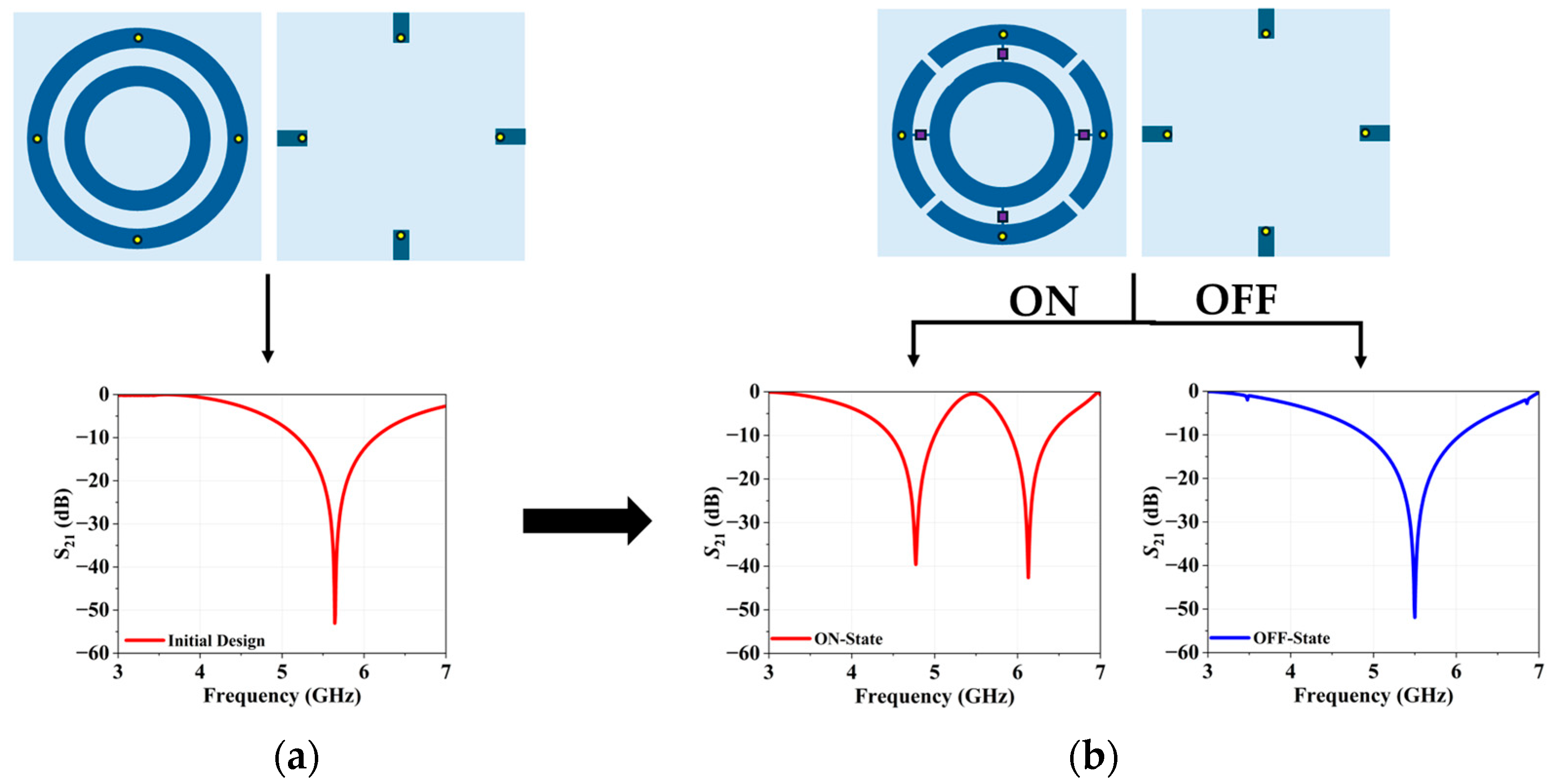



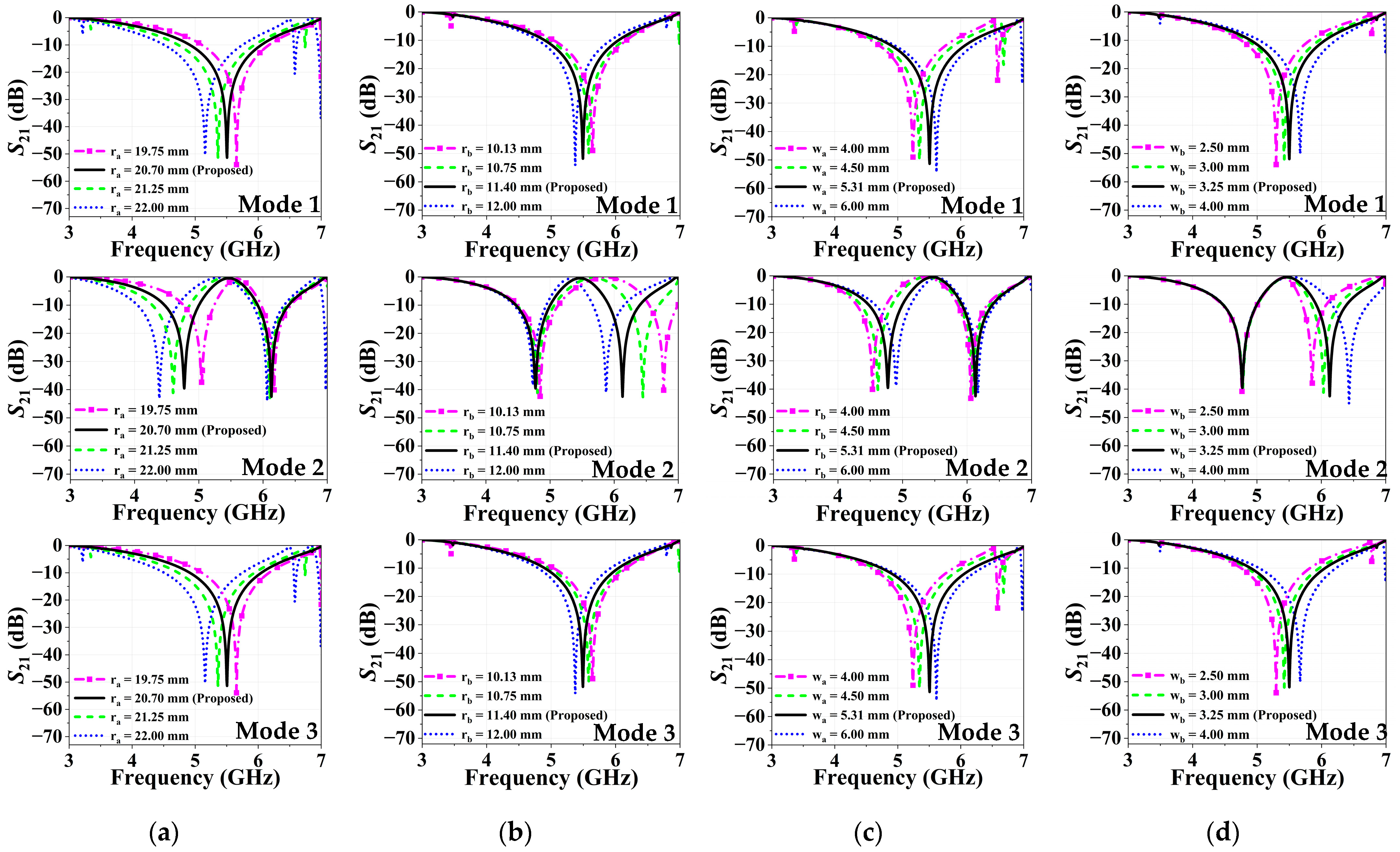
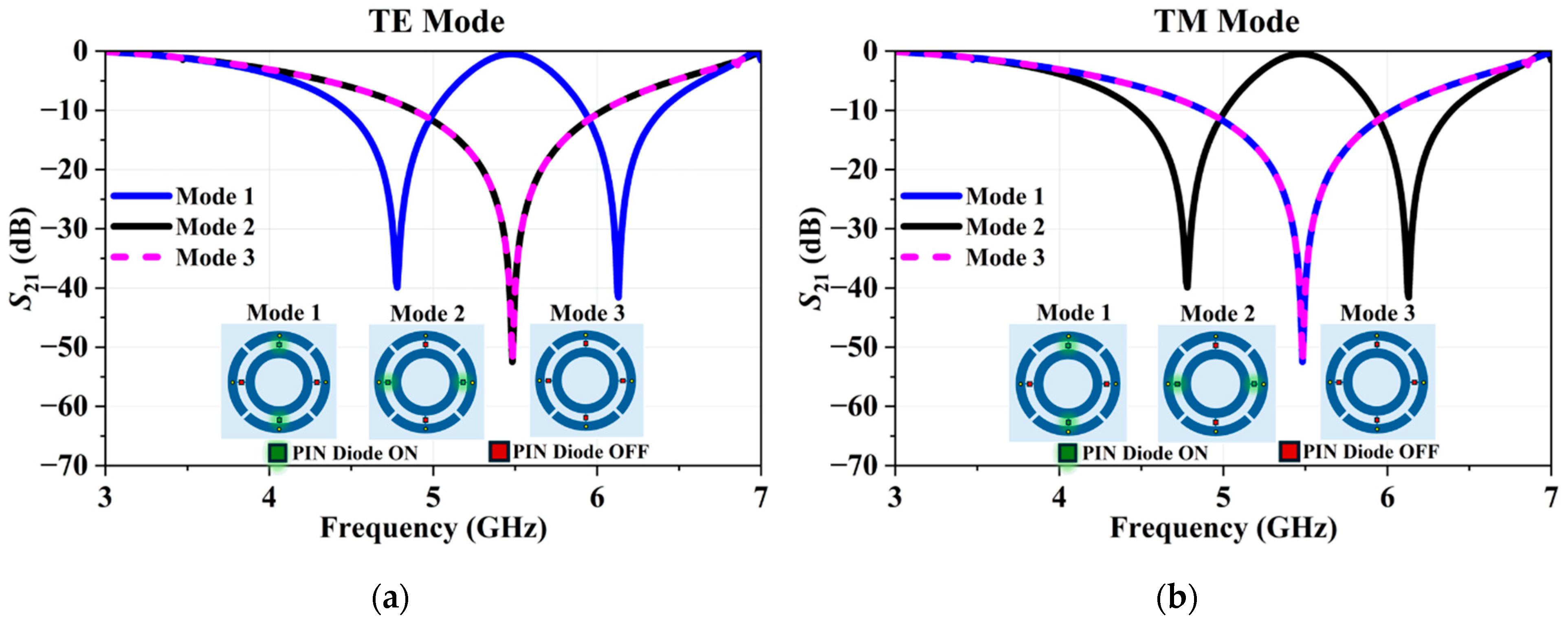
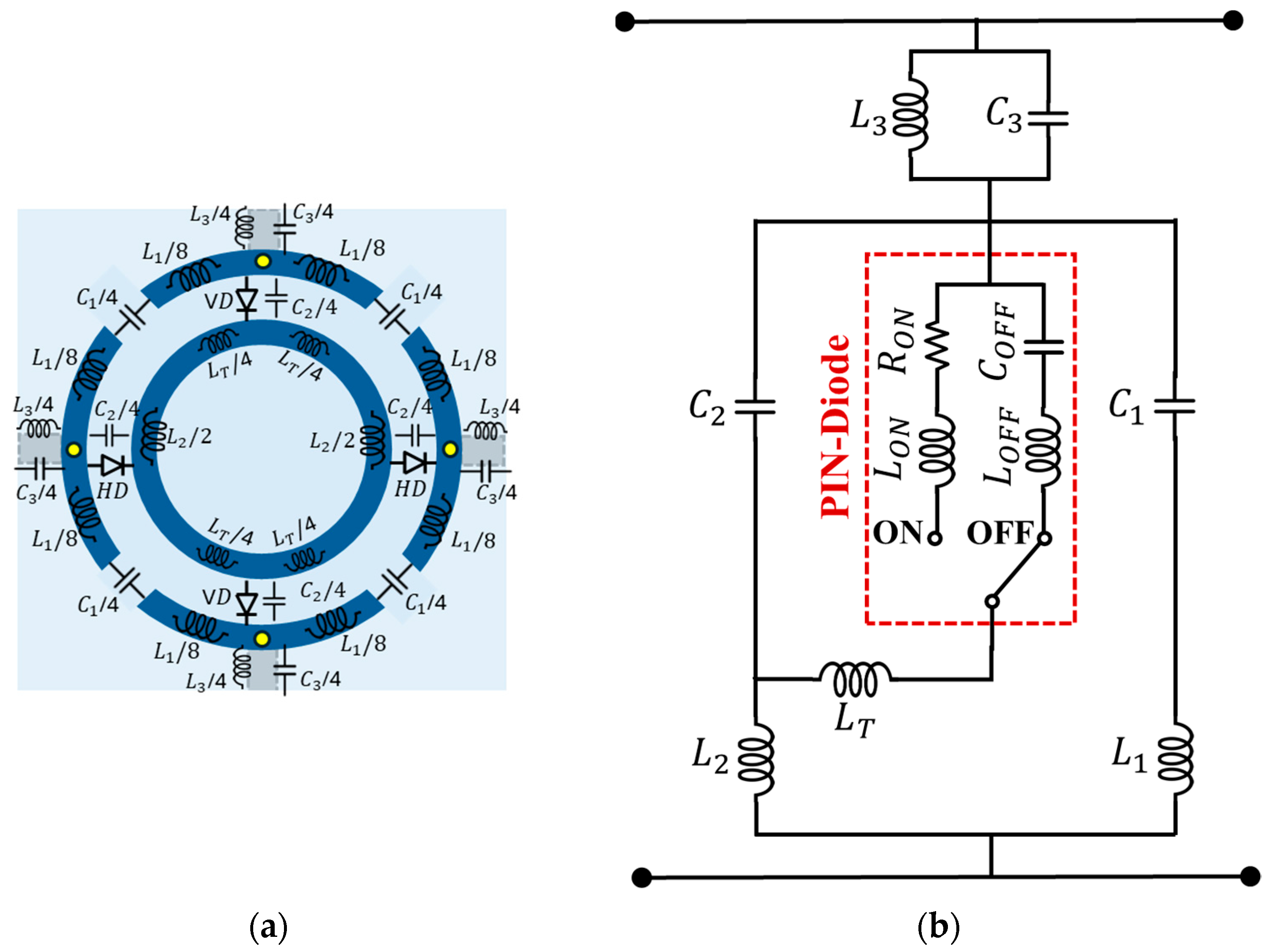
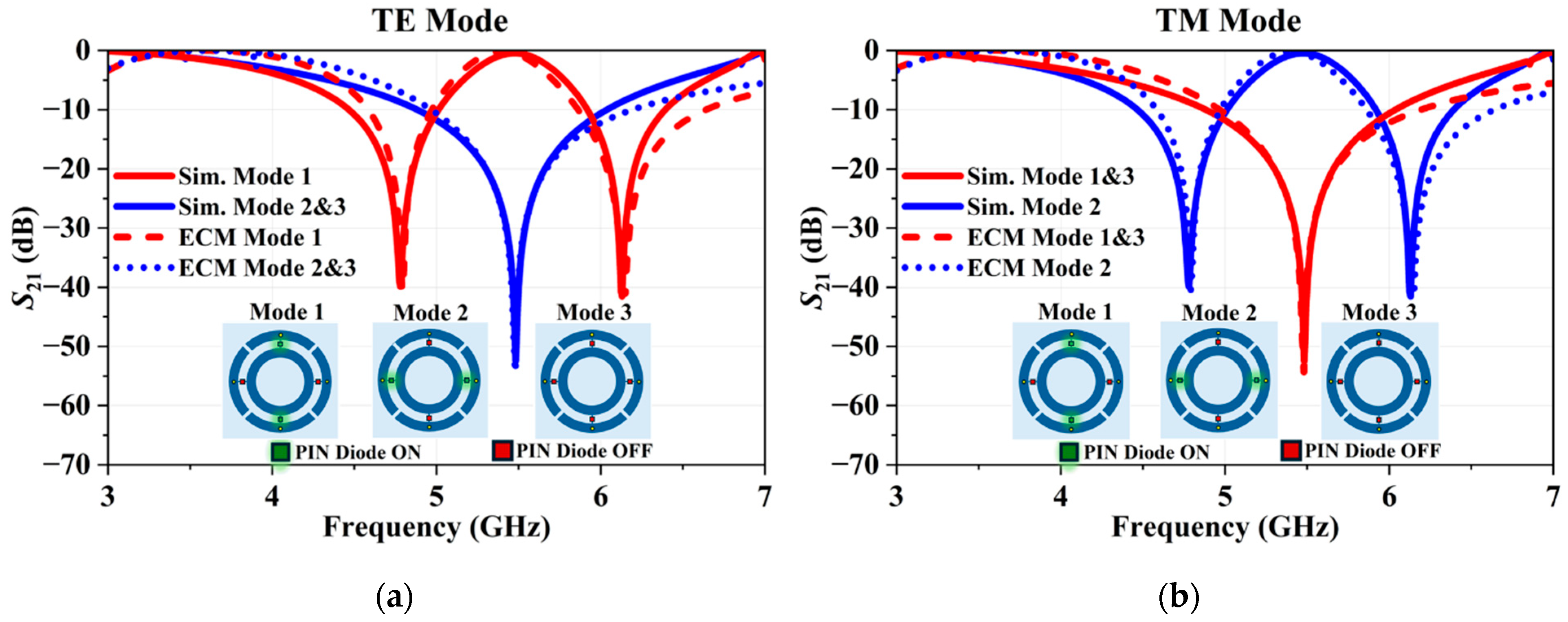
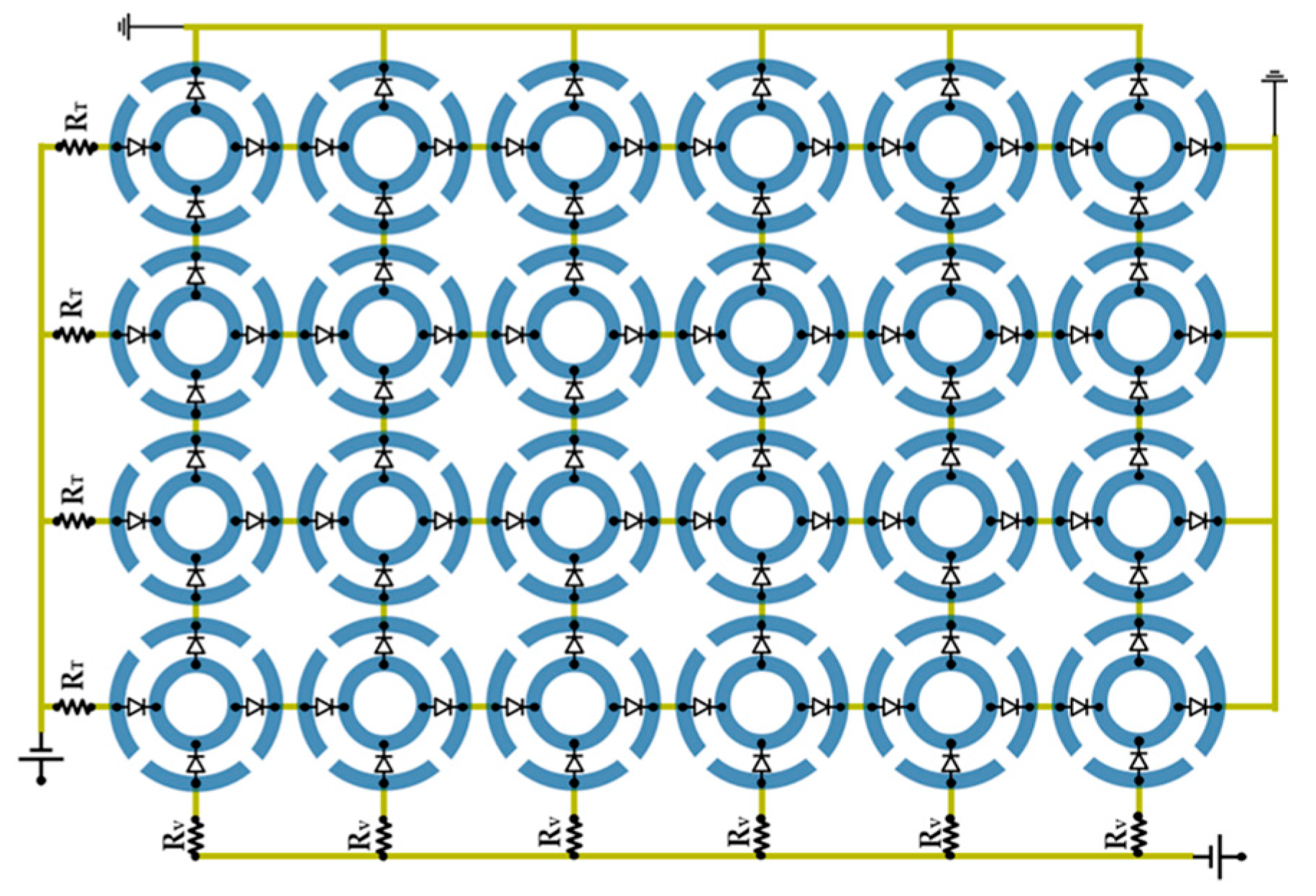



| R-FSS Mode | Diode States | |
|---|---|---|
| HD | VD | |
| Mode 1 | OFF | ON |
| Mode 2 | ON | OFF |
| Mode 3 | OFF | OFF |
| Parameter | ||||||||||
| Value | 45 | 45 | 20.70 | 11.40 | 5.32 | 3.25 | 0.85 | 1 | 0.15 | 4.46 |
Disclaimer/Publisher’s Note: The statements, opinions and data contained in all publications are solely those of the individual author(s) and contributor(s) and not of MDPI and/or the editor(s). MDPI and/or the editor(s) disclaim responsibility for any injury to people or property resulting from any ideas, methods, instructions or products referred to in the content. |
© 2025 by the authors. Licensee MDPI, Basel, Switzerland. This article is an open access article distributed under the terms and conditions of the Creative Commons Attribution (CC BY) license (https://creativecommons.org/licenses/by/4.0/).
Share and Cite
Uslu, B.; Bayer Keskin, S.E.; Türker Tokan, N. Dual-Mode Reconfigurable Frequency-Selective Surface for Switching Between Narrowband and Wideband Applications. Micromachines 2025, 16, 1030. https://doi.org/10.3390/mi16091030
Uslu B, Bayer Keskin SE, Türker Tokan N. Dual-Mode Reconfigurable Frequency-Selective Surface for Switching Between Narrowband and Wideband Applications. Micromachines. 2025; 16(9):1030. https://doi.org/10.3390/mi16091030
Chicago/Turabian StyleUslu, Batuhan, Sena Esen Bayer Keskin, and Nurhan Türker Tokan. 2025. "Dual-Mode Reconfigurable Frequency-Selective Surface for Switching Between Narrowband and Wideband Applications" Micromachines 16, no. 9: 1030. https://doi.org/10.3390/mi16091030
APA StyleUslu, B., Bayer Keskin, S. E., & Türker Tokan, N. (2025). Dual-Mode Reconfigurable Frequency-Selective Surface for Switching Between Narrowband and Wideband Applications. Micromachines, 16(9), 1030. https://doi.org/10.3390/mi16091030





